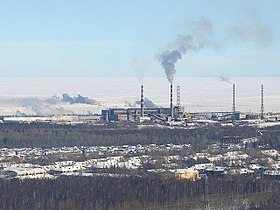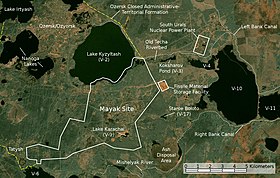Environmental issues in Russia
This articlemay need to be rewrittento comply with Wikipedia'squality standards,as Outdated.(November 2015) |
Environmental issues in Russiainclude pollution and erosion, and have impacts on people,wildlifeandecosystems.
Many of the issues have been attributed to policies that were made during the earlySoviet Union,at a time when many officials felt thatpollution controlwas an unnecessary hindrance to economic development andindustrialization,and, even though numerous attempts were made by the Soviet government to alleviate the situation in the 1960s, 1970s and 1980s, the problems were not completely solved.[1]By the 1990s, 40% of Russia's territory began demonstrating symptoms of significant ecological stress, largely due to a diverse number of environmental issues, includingdeforestation,energyirresponsibility,pollution,andnuclear waste.[2]According to Russia'sMinistry of Natural Resources and Environment,Russia is currently warming 2.5 times faster than the rest of the globe.[3]

Wildlife[edit]
Russia has manyprotected areas,such aszapovedniksand natural parks, which are made to preserve the natural state of environments. There are currently 101 zapovedniks that cover a total of over 33.5 million hectares.[4]However, some animals, such as theAmur tiger,polar bear,andCaucasian leopard,are facingextinction.The Russian government is attempting to revive those populations.[citation needed]A tiger summit was held in St. Petersburg in 2010 to discuss how to save the dwindling tiger population, which is threatened by deforestation andpoaching in Russia.[5]
Deforestation and logging[edit]
Excessiveloggingis causing the widespreaddeforestationof certain areas of Russia.[clarification needed]Despite efforts of Russian authorities to preserve forests usingnature reservesand parks, funding forpark rangersis lacking, limiting the protection of forests.[6]Illegal loggingis also widespread, especially in the north-west and in the Far East parts of Russia. It is estimated that Russia loses $1 billion every year due to illegal logging.[7]According to theCenter for Russian Environmental Policy,16 million hectares of forest are lost each year to a variety of causes, including logging, pollution, and fires. Inefficient logging andclearcuttingstrategies result in 40% of harvested trees never being used, and the implementation offorest protectionpolicies has been slow.[2]
Russia had a 2018Forest Landscape Integrity Indexmean score of 9.02/10, ranking it 10th globally out of 172 countries.[8]
Energy[edit]
Up to its collapse in 1991, the Soviet Union generated 1.5 times as much pollution per unit of GNP as the United States.[9]
Inefficient energy usageand the use offossil fuelsis another environmental issue that Russia faces. The Ministry of Energy stated that upgrading energy sector equipment could cutcarbon emissionsby 25%, and the Energy Research Institute predicts that such measures could save up to $1 billion of fuel every year.[10]68% ofRussia's energyis produced by polluting fossil fuels, and it is a large producer of those fuels.[11]
Pollution[edit]

Air pollution[edit]
This sectionmay need to be rewrittento comply with Wikipedia'squality standards.(November 2015) |
Moscow,St. Petersburg,Yekaterinburg,andVolgograd,as well as other major industrial and population centers, have the highest concentrations of air pollution.[2]Overall, over 200 cities in Russia exceed pollution limits, and this is increasing as more vehicles appear on the roads.[10]Before the 1990s, most air pollution came from industries. When industrial production declined, emissions of air pollutants from those sources also declined, although the amount of motor vehicles on the roads skyrocketed. Currently, vehicle emissions exceed industry emissions in most Russian cities.[12]Air pollution is attributed to 17% of childhood and 10% of adult diseases, as well as 41% ofrespiratoryand 16% ofendocrine diseases.[10][12]
Water pollution[edit]
This sectionmay need to be rewrittento comply with Wikipedia'squality standards.(November 2015) |
Water pollutionis a serious problem in Russia, and 75% ofsurface water,and 50% of all water in Russia is now polluted.[2]Towards the end of the Soviet era the government increasingly recognized the need to take care of thespawning sitesand habitats of fish, in order to returnfish catchesto what they had been.[13]This has caused health issues in many cities as well as in the countryside, as only 8% ofwastewateris fully treated before being returned to waterways. Obsolete and inefficientwater treatment facilities,as well as a lack of funding, have caused heavy pollution, and has also resulted in waterborne disease spread, such as an outbreak ofcholeraspread by theMoskva Riverin 1995.Industrialandchemical wasteis often dumped into waterways, includinghydrogen sulfide,which has been linked to the large-scale death of fish in the Black and Caspian seas.Lake Baikalwas previously a target of environmental pollution from paper plants, but cleanup efforts since then have greatly reduced the ecological strain on the lake.[2]

Unsafe dumping methods have been used sometimes to get rid of militarynuclear waste,which was dumped into theSea of Japanuntil 1993.[6]The testing and production ofnuclear weaponsalso affected the environment, such as at theMayakatomic weapons production plant nearChelyabinsk.[6]
Radioactive Waste[edit]
Radioactive wastecan be described as high-level waste or low-level waste.High-level wasteis what can be seen as the waste from the use of nuclear fuel which is typically stored at the site of the nuclear power plant is it produced from. This can also include the waste produced by the mining ofuraniumandthoriumboth of which are key components for the usage of nuclear fuel.Low-level wasteconsists of things that have come in contact with radioactive waste such as packaging, clothing, and other similar materials found on site. The main difference between the two categories is the level of radioactivity one would be exposed to when coming into contact with these materials. According to theWorld Nuclear Association,low-level waste is no more than four giga-becquerels per tonne of alpha activity or twelve giga-becquerels per tonne of gamma-beta activity.[14][15]
An example of the effects of radioactive waste can be seen in the construction of the SouthEast Chord highway. Since 2018, Moscow's Department for Transportation and Construction has attempted to create an eight-lane highway over what is now an inactivenuclear plant.The Moscow Polymetal Plant, owned byRosatom State Energy Corporation,was shut down over 50 years ago and is said to still contain harmful nuclear waste resulting in it being labeled a radioactive site. Its main purpose was for the extraction and production of uranium and thorium resulting in high levels of radiation in the surrounding area (reported by the environmental justice organizationGreenpeace). The Government of Moscow andRadon State Unitary Enterprise,both responsible for the management of radioactive waste, have claimed that appropriate measures of decontamination have taken place in order for construction of the highway to commence.[16][17][18][19][20]
The main conflict associated with the SouthEast Chord project is nuclear waste storage and its harmful effects to human health and the surrounding environment making this site unsafe for the usage of a highway. According to theCenter for Disease Control and Preventionand their article on the effects of radiation on the human cause, radioactive waste can directly damage the structure of one's DNA as well as major organs. This alteration of DNA can leave victims at high risk of cancer or even death. Ultimately, this all depends on the radiation dosage and, in this case, how frequently a civilian were to drive on this portion of the SouthEast Chord. The main contaminants highlighted are the extraction of uranium and production of thorium for the purpose of nuclear reactors.[21][22]
Other forms of pollution[edit]
This sectionneeds expansion.You can help byadding to it.(January 2015) |
Soil erosion[edit]
Snow run-off has caused substantialerosionin pastures and croplands in northern Russia, particularly near theUral Mountains.In parts of southern Russia,overgrazinganddeforestationhas resulted in large plots of bare soil which are highly susceptible to wind erosion.[23]
See also[edit]
- Environment of Russia
- Energy policy of Russia
- Renewable energy in Russia
- Climate change in Russia
- Environmental issues in Lake Baikal
- Pollution in the Gulf of Finland
References[edit]
- ^Sobisevich, A. V.; Snytko, V. A.; Postnikov, A. V. (2019)."The surrounding environment monitoring in the Soviet Union: A review of establishing new" ecological "science".IOP Conference Series: Earth and Environmental Science.350:012017.doi:10.1088/1755-1315/350/1/012017.
- ^abcde Curtis, Glenn E., ed. (1996)."Russia: A country study".Environmental problems. Washington: GPO (United States Government Printing Office) for theLibrary of Congress.Retrieved2011-12-13.
- ^Antonova, Maria (2015). "warming '2.5 times quicker' than global average: ministryArchived2023-01-02 at theWayback Machine".Yahoo News.Agence France-Presse.
- ^"Welcome to Wild Russia".Center for Russian Nature Conservation.Retrieved2011-02-22.
- ^Kathy Lally (2010-11-23)."World leaders meet at tiger summit in Russia, pledge protection and cooperation".Washington Post.Retrieved2011-02-22.
- ^abc"Environmental issues in Russia".Norges Naturvenforbund. Archived fromthe originalon 2013-05-01.Retrieved2011-02-22.
- ^"Environmental problems in Russia".WWF.Retrieved2011-02-22.
- ^Grantham, H. S.; Duncan, A.; Evans, T. D.; Jones, K. R.; Beyer, H. L.; Schuster, R.; Walston, J.; Ray, J. C.; Robinson, J. G.; Callow, M.; Clements, T.; Costa, H. M.; DeGemmis, A.; Elsen, P. R.; Ervin, J.; Franco, P.; Goldman, E.; Goetz, S.; Hansen, A.; Hofsvang, E.; Jantz, P.; Jupiter, S.; Kang, A.; Langhammer, P.; Laurance, W. F.; Lieberman, S.; Linkie, M.; Malhi, Y.; Maxwell, S.; Mendez, M.; Mittermeier, R.; Murray, N. J.; Possingham, H.; Radachowsky, J.; Saatchi, S.; Samper, C.; Silverman, J.; Shapiro, A.; Strassburg, B.; Stevens, T.; Stokes, E.; Taylor, R.; Tear, T.; Tizard, R.; Venter, O.; Visconti, P.; Wang, S.; Watson, J. E. M. (2020)."Anthropogenic modification of forests means only 40% of remaining forests have high ecosystem integrity - Supplementary Material".Nature Communications.11(1).doi:10.1038/s41467-020-19493-3.ISSN2041-1723.PMC7723057.PMID33293507.
- ^Shahgedanova, Maria; Burt, Timothy P (1994)."New data on air pollution in the former Soviet Union".Global Environmental Change.4(3): 201–227.Bibcode:1994GEC.....4..201S.doi:10.1016/0959-3780(94)90003-5.
- ^abc"The Environmental Outlook in Russia".National Intelligence Council. January 1999. Archived fromthe originalon May 28, 2010.Retrieved2011-02-22.
- ^"Russia- Electrity".U.S. Energy Information Administration. November 2010. Archived fromthe originalon December 28, 2010.Retrieved2011-01-23.
- ^ab"TED Case Studies: Russia Air Pollution".American University. Archived fromthe originalon 2013-03-29.Retrieved2011-02-22.
- ^Astakhov, Alexander S.; Khaitun, A. D.; Subbotin, G. E. (1989)."Socioeconomic Aspects of Oil and Gas Development in West Siberia".Annual Review of Energy and the Environment.14(1).Annual Reviews:117–130.doi:10.1146/annurev.eg.14.110189.001001.ISSN0362-1626.S2CID154741203.
- ^"Radioactive Waste Management | Nuclear Waste Disposal - World Nuclear Association".world-nuclear.org.Retrieved2022-12-12.
- ^US EPA, OAR (2018-11-28)."Radioactive Waste".www.epa.gov.Retrieved2022-12-12.
- ^EJOLT."Construction of a highway over a radioactive waste disposal site, Moscow, Russia | EJAtlas".Environmental Justice Atlas.Retrieved2022-12-05.
- ^"Greenpeace требует остановить строительство у могильника радиоактивных отходов в Москве".Greenpeace в России(in Russian). Archived fromthe originalon 2022-12-05.Retrieved2022-12-05.
- ^"'Everything is very bad': Locals fear radiation spikes as Moscow plans new highway across nuclear waste dump ".The Independent.2019-10-27.Retrieved2022-12-05.
- ^"Greenpeace - Nuclear Waste Research in the South-East Chord, Moscow".www.media.greenpeace.org.Archived fromthe originalon 2022-12-12.Retrieved2022-12-12.
- ^EJOLT."Construction of a highway over a radioactive waste disposal site, Moscow, Russia | EJAtlas".Environmental Justice Atlas.Retrieved2022-12-12.
- ^CDC (2021-08-09)."Health Effects of Radiation".Centers for Disease Control and Prevention.Retrieved2022-12-12.
- ^CDC (2022-08-31)."About CDC".Centers for Disease Control and Prevention.Retrieved2022-12-12.
- ^Frederick R. Troeh; J. Arthur Hobbs & Roy L. Donahue (2003).Soil and Water Conservation for Productivity and Environmental Protection(4th ed.). Prentice Hall. p. 31.ISBN978-0130968074.
Center for Russian Nature Conservation. Retrieved 2011-02-22.
External links[edit]
- Shahgedanova, Maria; Burt, Timothy P (September 1994)."New data on air pollution in the former Soviet Union".Global Environmental Change.4(3): 201–227.doi:10.1016/0959-3780(94)90003-5.
